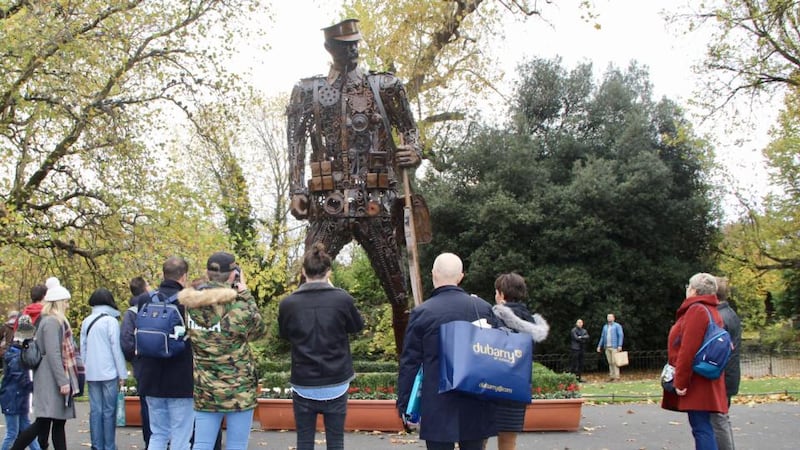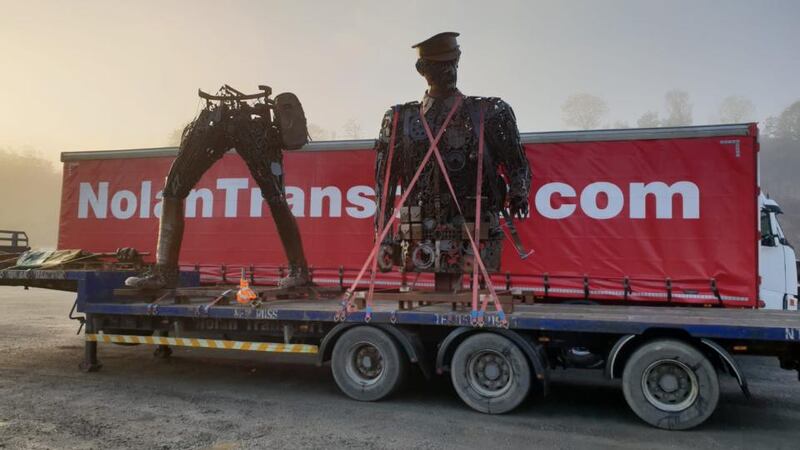Few art works associated with the first World War are as impressive as the Haunting Soldier.
Created in 2017 in Dorset, England, from bits of scrap metal, this monumental installation, more than six metres in height, depicts a weary and haunted-looking first World War soldier with a pack, leaning on his rifle.
On Saturday morning it was installed near the entrance to St Stephen's Green, Dublin, overseen by its creator, Dorset-based blacksmith Martin Galbavy, and Chris Hannam, who owns the forge where the Haunted Soldier was assembled.
It has already had thousands of visitors in Dublin, who came to see it or were passing through St Stephen’s Green on Saturday.

Galbavy created the sculpture from a commission by Dorset woman Jo Oliver, who wanted something that resembled a weary soldier coming back from the war.
He used horse shoes, bed springs, brake discs, spanners and other assorted metal detritus, right down to the detail of the soldier’s shoelaces, which are made of chains.
The artwork came to the attention of Dublin-based solicitor Sabina Purcell, who had set up the website www.worldwar1veterans.com as a voluntary project in 2011. The site lists many of those from Ireland who returned from the war, and Ms Purcell now has close to 40,000 names listed on it.
She said she wanted to mark the centenary of the armistice in a way that would be memorable in Ireland. Then she came across photographs of the Haunting Soldier.
"It was the Haunting Soldier, eyes so weary from battle, that resonated with me the most," she said.
‘So weary from battle’
"I could imagine every person, man and woman, must have been so weary from battle and beyond at some time in World War 1. I endeavoured to bring the Haunting Soldier to Dublin to commemorate the end of World War 1."
Ms Purcell said reaction in Dublin to its striking presence has “exceeded my expectations. There are hordes of people around it taking photos. I’m so moved by the respect being shown to it by members of the public.”
Getting it to Ireland has been more than a year in the planning. Having gotten permission from the owner, Ms Oliver, she then sought the support of the Office of Public Works (OPW) to put it in a prominent public place.

The OPW agreed to allow the sculpture to be located at St Stephen's Green. It is located near the Grafton Street/Fusiliers' Arch entrance.
The Department of Culture, Heritage and the Gaeltacht lent its support to the plan, while various companies are also acting as sponsors: Nolan Transport removed the work to St Stephen's Green, strapped onto a 45ft trailer; construction company Sisk put in the foundations, while AIG provided the public insurance.
There will be short unveiling ceremony on Sunday afternoon at 2.30pm for the Haunting Soldier. The sculpture will remain at St Stephen's Green until November 26th.
On Saturday afternoon, Lord Mayor of Dublin Cllr Nial Ring unveiled a plaque on the spot at Dublin Port where a munitions factory which employed 200 local women was located during the first World War.







